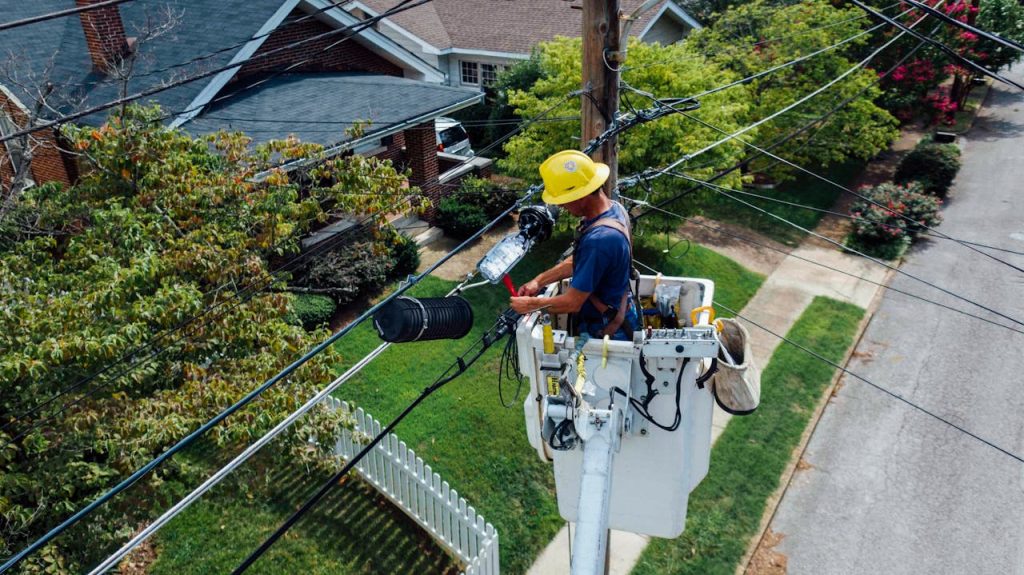Lineworkers build and maintain the high-voltage power lines that deliver electricity to homes and businesses. This is a critical and highly skilled trade.
Key Duties:
- Climb utility poles or use bucket trucks to install, repair, or replace electrical power lines and equipment (transformers, cross-arms).
- Restore power after storms by reconnecting lines and fixing downed cables.
- Test circuits and use safety gear (insulated tools, rubber gloves) to work live when necessary.
Training & Certification:
- Complete a lineman apprenticeship (typically 3–4 years) through a utility company or union.
- Apprenticeships combine paid on-the-job work with classroom instruction in electrical theory and safety.
- Many earn journeyman status before advancing.
Apprenticeship:
- Common through utility companies, IBEW (power lineman locals), and associations like the National Electrical Contractors Association (NECA). Apprentices earn increasing wages each year and graduate with a lineman certification.
Salary Range:
- ~$70k–$120k per year (median ~$92,560). Top linemen in high-cost areas or those who become contractors can earn well above this.
Job Outlook:
- +8% growth (2023–33) , faster than average. Demand stems from replacing aging grid infrastructure and adding new renewable energyconnections.
Work Environment:
- Outdoors, often at heights (up to 100+ feet). Work is physically demanding (climbing poles, heavy equipment)and can be done in extreme weather. Safety hazards include high- voltage shocks and falls, so strict safety protocols (hoods, insulatedgear) are used. Linemen often work long shifts during storm restorations and may be on call.
Pros & Cons:
- Pros: Excellent pay and benefits; strong union support; essential infrastructure work (job security); variety (new construction vs. emergency repairs); sense of accomplishment restoring power.
- Cons: Dangerous job (high voltage, heights); strenuous (climbing, heavy tools); irregular hours (storm response, outages); must maintain peak fitness and focus on safety.
Path to Entry:
- Finish high school (focus on math, physics, mechanical drawing).
- Enroll in a lineworker training program or pre-apprenticeship (some community colleges offer line tech courses).
- Apply for a lineman apprenticeship (many utilities hire through these programs).
- Complete a 3–4 year apprenticeship (paid training and classes on electronics and pole-climbing).
- Earn certification or state journeyman lineman license (if required).
Career Advancement:
- Crew leader or supervisor; substation electrician; electrical foreman; safety trainer; purchase power lineman contractor. Further training can lead to power grid control or engineering
Recommended Resources:
- IBEW/NECA Lineworker Programs: Joint training centers for
- Utility Companies: Many have “lineman training schools” (e.g., Colorado’s Platte River, Florida’s TECO).
- Association of Lineman & Telephone Workers (NRECA): Resources on career and
Video Resource: “Life as a Power Lineman” (documentary clips on trade training).
Solar PV installers put up and maintain solar panel systems on roofs or ground-mounted arrays. This trade is growing rapidly with the renewable energy boom.
Key Duties:
- Assess installation site (shading, structure); mount solar panels on roofs or racks
- Wire panels together and connect them to inverters and electrical service panels
- Troubleshoot system performance and issues
Training & Certification:
- Training program or certificate in solar installation (many community colleges offer this).
- Knowledge of electrical systems is required (similar to electrician skills).
- NABCEP (North American Board of Certified Energy Practitioners) certification is highly recommended and often required by employers.
Salary Range:
- ~$35k–$65k per year (median ~$51,860). Experienced installers and team leads earn at the high end.
Job Outlook:
- +48% growth (2022–32), reflecting strong demand as solar becomes more common.
Work Environment:
- Outdoors, on rooftops or open fields. Work involves heights (roof work) and requires safety harnesses. Installers may deal with hot, sunny conditions. Typical schedule is full- time, but may have seasonal fluctuation (more work in sunnier months).
Pros & Cons:
- Pros: Fast-growing field; work on green energy; mostly entry-level friendly (short training needed); can be physically active/outdoors.
- Cons: Roofing is strenuous and risky (slips, falls); subject to weather conditions; physical labor (heavy panels); must work carefullyto follow electrical
Path to Entry:
- Finish high school (take classes in math, electronics, or construction).
- Complete a solar installer training course or apprenticeship
- Obtain NABCEP PV Installation Professional certification (widely recognized standard).
- Train on-the-job with a solar installation
- Stay updated on PV technologies and electrical
Career Advancement:
- Senior installer/team lead; project manager for solar installations; energy auditor; transitions to PV system design or renewable energy sales.
Recommended Resources:
- NABCEP: Certification programs for solar PV
- Solar Training Programs: Colleges and trade schools offering solar certification (e.g. SEI Solar Energy International courses).
- SEIA (Solar Energy Industries Association): Industry information and job
Video Resource: “How to Install Solar Panels” (demonstration videos on YouTube).

